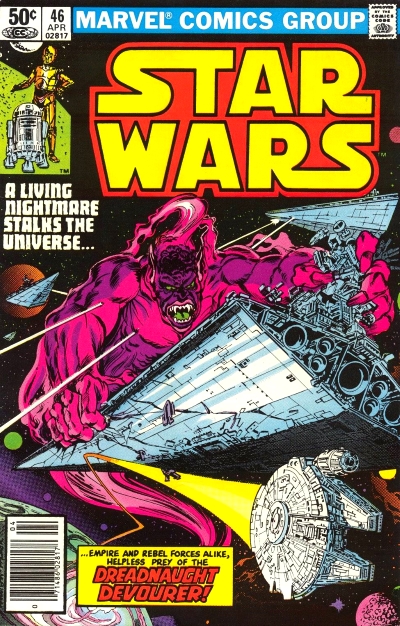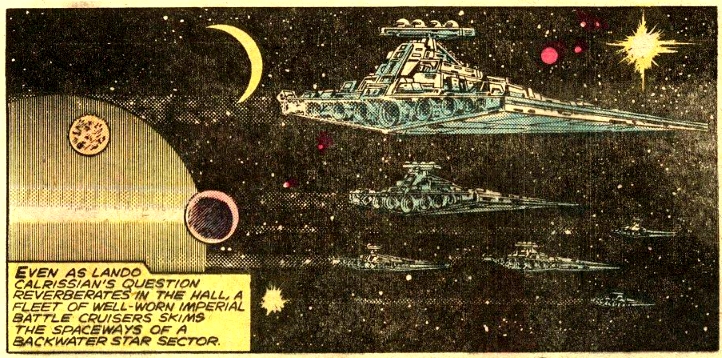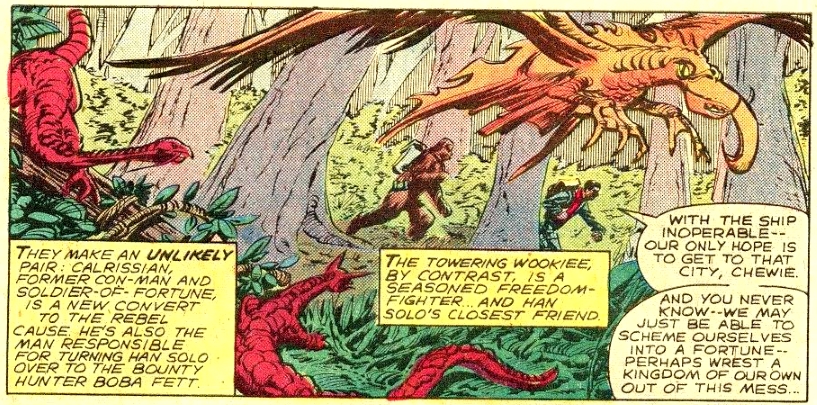Star Wars #46Cover dated: April 1981
Issue title:
The Dreams of Cody Sunn-Childe!Script: J. M. DeMatteis (credited under the pseudonym of Wally Lombego)
Artwork: Carmine Infantino (pencils)/Tom Palmer (inks)
Colours: Glynis Wein
Letters: Diana Albers
Cover art: Ed Hannigan (pencils)/Tom Palmer (inks)
Overall rating: 9 out of 10
 Plot summary
Plot summary: While searching the space ways for their friend Han Solo, Lando Calrissian and Chewbacca have a mechanical problem with the
Millennium Falcon's engines, which throws the freighter off into another dimension. Coming upon a mysterious floating city, the pair land and soon come face to face with the long lost Rebel hero Cody Sunn-Childe. The near-legendary warrior explains that after gaining powerful mystic abilities he turned his back on the violence of his past and created a floating "City of Dreams" using his psychic powers. Sunn-Childe tells the pair that he is now content to live with his friends in peace, far away from the violence of the Empire and the Galactic Civil War.
Lando rejects Sunn-Childe's philosophy, arguing that sometimes violence is necessary in order to combat great evil. Appalled by what he perceives as Cody's cowardice, Lando readies the
Falcon for take off, just as a fleet of Imperial Star Destroyers launch an attack on the floating city, having found an opening in the space-time continuum leading to the alternate dimension. As Lando and Chewbacca blast off and engage the Imperials in battle, Cody gives in to his warrior instincts and unleashes a horde of psychic demons that attack the Star Destroyers. However, the one-time freedom fighter suddenly comes to his senses and decides to hold true to his pacifist ideals, allowing himself and his beloved city to be destroyed.
Surveying the shattered remnants of Sunn-Childe's paradise-like retreat, Lando tearfully concludes that the former Rebel was wrong to believe that his pacifist ideals would lead him along the right path when dealing with the Empire. Turning the
Falcon towards a rapidly closing rent in the fabric of space that leads back to their own galaxy, Lando and Chewbacca leave the Imperial fleet imprisoned in this strange dimension as part of what Lando calls "Sunn-Childe's revenge."
Comments: The first thing to say about issue #46 of
Star Wars is how much better Carmine Infantino's artwork looks here, when compared to the previous issues that he'd drawn. We know from comments that writer and comic historian Glenn Greenberg posted a few days back in this thread that the book's new editor, Louise Jones, had decided to make a concerted effort to have the comic be more visually faithful to the movies – and there's ample evidence of that here! Pairing Infantino with a strong and highly detailed inker like Tom Palmer serves to smooth out all those annoyingly over-angular tendencies that I've moaned about time and time again during these reviews.
As is often the case with Palmer's inking, he very much puts his own stamp on the finished art, while simultaneously still managing to be sensitive to the artist's pencilling. That being said, on occasion it's kind of hard to see Infantino's influence at all in some of the artwork in this comic and, as a result, I definitely suspect that parts of this issue were completely redrawn by Palmer. For example, in some of the panels in which appear, the fleet of Imperial Star Destroyers look very much like Infantino's work...

While in others, the Empire's warships look a little too much like they did in the
Star Wars films for them to be based on Infantino's pencils, I feel...

Still, for the majority of the time, Infantino's signature style is clearly discernible. In addition, the staging, the "camera angles" chosen and the sheer clarity and fluidity of the storytelling very much have Infantino's mark on them. What Palmer brings to the table is making this issue actually look like it's set in the cinematic
Star Wars universe. Indeed, based on this issue, I kinda wish that Palmer had been brought in to ink Infantino much, much earlier – say, from issue #18 onwards, when Bob Wiacek and Gene Day came on board as the series' regular inkers. Palmer really does elevate the artwork here to a level that we've rarely seen in the series. This is hardly surprising though: like I said in my review of
Star Wars #8, I long ago realised that when it comes to comic books, everything's better with added Tom Palmer!
Star Wars #46 was the first and only issue to be written by John Marc DeMatteis (more usually known as plain ol' J. M. DeMatteis), although he's credited as Wally Lombego here. DeMatteis was relatively new to Marvel at the time, having only recently begun working as a writer on
The Defenders, though he would later go on to write such high profile titles as
The Amazing Spider-Man and
Justice League International for Marvel and DC respectively (as well as penning the celebrated Spider-Man classic "Kraven's Last Hunt"). The reason for the pseudonym was because DeMatteis became infuriated by editorial changes that were forced upon his story by Lucasfilm and he decided that he no longer wished to be associated with it. DeMatteis takes up the story himself in this edited excerpt from a 2010 post on his personal blog...
"I got to work crafting a tale about Lando Calrissian and his encounter with a legendary rebel fighter, of my own creation, named Cody Sunn-Childe. Note the name, please: Cody Sunn-Childe. You see, my son Cody was born right around the time I got the assignment and, y'know, he's my son. And my child.
I thought it would be an interesting touch to have Cody Sunn-Childe, this great warrior that Lando Calrissian idolized, go through a spiritual transformation and become a pacifist. In the end, although an attack by the Empire tempts Sunn-Childe to return to his old ways, he decides that it's better to allow himself to be killed, to die for a dream of peace, than to go down fighting. Keep in mind that I didn't belittle the Star Wars characters, or their beliefs, in any way: I was just presenting another point of view while keeping Calrissian and company true to their roots. They had their views, Sunn-Childe had his: let the readers decide who, if anyone, was right. "The Dreams of Cody Sunn-Childe" wasn't a brilliant piece of work by any means, but I think it had something of value to say. And it was a "something" I wanted to pass on to my newborn son – which is why I named that new character after him.
The book went off to the Lucasfilm reps for approval. They weren't happy. It seemed that, to them, the very idea that a character in the Star Wars universe would voice an opinion that in any way contradicted the Skywalker Worldview was offensive. The word came down that Sunn-Childe, in rejecting violence, made their characters look bad.
Marvel had to keep the Lucas people happy: new dialogue was written for the last page – not by me! – and I’ll never forget this line that was added: "He died for his dream of peace," Calrissian said, "but he was wrong." No maybes about it: Cody Sunn-Childe was an idiot who sacrificed his life for nothing.
To me, the Lucas people were the ones who were wrong; so wrong, in fact, that I took my name off the story, replacing it with the admittedly, and intentionally, ridiculous nom de plume Wally Lombego."So there you have it! Well, almost...because what DeMatteis may not have known is that over here in the UK, his story was published in its unaltered form and with his real name listed in the credits! Below is a scan of that heavily edited final page of
Star Wars #46, which so upset its author, followed by a scan of the same page as it appeared in Marvel UK's
The Empire Strikes Back Monthly #141. The latter version is how DeMatteis originally intended for his story to end...


Of the two endings, I find it hard to decide which one I actually prefer. DeMatteis's unaltered ending definitely fits the tone of the tale better and I like that Lando actually learns something of Sunn-Childe's philosophy at the story's conclusion. However, I also liked the revenge angle of Lando just leaving the Imperials trapped in that other dimension to rot. That felt very in character to me and I liked seeing them get their just deserts, with Lando's actions providing an interesting juxtaposition to Sunn-Childe's. I think ultimately it's a pity that DeMattis's original ending couldn't have included Lando leaving the Imperials trapped, while still having him realise that Cody's course of action was a noble one and not wrong.
Leaving behind the controversy about this issue's ending for a moment, it's really cool to see Lando and Chewbacca in an adventure together for the first time. In Lando's case, this is the first time that we've seen this newest addition to the central cast in a story outside of the
Star Wars films. To his credit, DeMatteis gets Lando's character pretty much spot on straight away. He also writes an interesting dynamic between Lando and the Wookiee, with it being pretty obvious that Chewbacca still doesn't wholly trust his partner and, considering recent events in
The Empire Strikes Back, that's very understandable.
On the downside, there's possibly a slight continuity problem here when Lando states that he saw Sunn-Childe in action against the Empire as a boy. Lando is in his mid-30s and we know from the prequel trilogy that the Empire didn't replace the Old Republic until 18 years before
Star Wars: Episode IV – A New Hope. That means that even if Lando saw Sunn-Childe resisting the Empire very soon after the events of
Star Wars: Episode III – Revenge of the Sith, he would've still been 14 or 15 at the time. That's not really a boy, more like a young adult. Still, I'm gonna let this one slide because I guess that a 15-year-old could still legitimately be termed "a boy." My suspicion though is that DeMatteis really meant for Lando to be much younger than that, but subsequent revelations in
Star Wars continuity have made that impossible.
Another complaint about this issue would be that, during the battle against the Imperials, Lando seems to be ramming the
Millennium Falcon against the edges of the attacking Star Destroyers. Surely that would cause a lot of damage to the Corellian freighter? Maybe the
Falcon's shields were up full or something, thus preventing the ship from sustaining any damage itself. Still, it seems like an odd way to do battle.
Overall, this is an interesting and very thought-provoking issue. The fact that Cody believes that it's more important to stay true to his beliefs and die, than it is to give in to violence and survive, makes this a morally complex story. As such, it blows a great big raspberry at those who would dismiss the old Marvel series as being childish or unsophisticated. This is heavy, mature, philosophical stuff.
That said,
Star Wars #46 still has enough action in it to thrill fans of space opera and I certainly liked this issue a whole lot as a kid. I read and re-read this story until my copy almost fell apart and today I get a warm, fuzzy glow of nostalgia from revisiting it, which will ultimately cloud my judgement when it comes to rating this comic. It's a pity about the editorially mandated ending in the U.S. comic, but being a Brit, the way the story ended for me is exactly the way that DeMattis intended. Either way though, I consider this to be a really top draw entry in Marvel's
Star Wars series.
Continuity issues: None.
Favourite panel:
 Favourite quote
Favourite quote: "Your truth is not my truth." – Cody Sunn-Childe cryptically espouses his non-violent philosophy to Lando Calrissian.